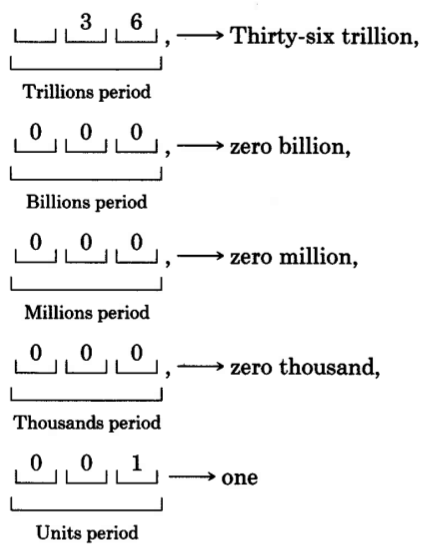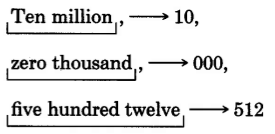1.2: Reading and Writing Whole Numbers
- Page ID
- 48775
\( \newcommand{\vecs}[1]{\overset { \scriptstyle \rightharpoonup} {\mathbf{#1}} } \)
\( \newcommand{\vecd}[1]{\overset{-\!-\!\rightharpoonup}{\vphantom{a}\smash {#1}}} \)
\( \newcommand{\id}{\mathrm{id}}\) \( \newcommand{\Span}{\mathrm{span}}\)
( \newcommand{\kernel}{\mathrm{null}\,}\) \( \newcommand{\range}{\mathrm{range}\,}\)
\( \newcommand{\RealPart}{\mathrm{Re}}\) \( \newcommand{\ImaginaryPart}{\mathrm{Im}}\)
\( \newcommand{\Argument}{\mathrm{Arg}}\) \( \newcommand{\norm}[1]{\| #1 \|}\)
\( \newcommand{\inner}[2]{\langle #1, #2 \rangle}\)
\( \newcommand{\Span}{\mathrm{span}}\)
\( \newcommand{\id}{\mathrm{id}}\)
\( \newcommand{\Span}{\mathrm{span}}\)
\( \newcommand{\kernel}{\mathrm{null}\,}\)
\( \newcommand{\range}{\mathrm{range}\,}\)
\( \newcommand{\RealPart}{\mathrm{Re}}\)
\( \newcommand{\ImaginaryPart}{\mathrm{Im}}\)
\( \newcommand{\Argument}{\mathrm{Arg}}\)
\( \newcommand{\norm}[1]{\| #1 \|}\)
\( \newcommand{\inner}[2]{\langle #1, #2 \rangle}\)
\( \newcommand{\Span}{\mathrm{span}}\) \( \newcommand{\AA}{\unicode[.8,0]{x212B}}\)
\( \newcommand{\vectorA}[1]{\vec{#1}} % arrow\)
\( \newcommand{\vectorAt}[1]{\vec{\text{#1}}} % arrow\)
\( \newcommand{\vectorB}[1]{\overset { \scriptstyle \rightharpoonup} {\mathbf{#1}} } \)
\( \newcommand{\vectorC}[1]{\textbf{#1}} \)
\( \newcommand{\vectorD}[1]{\overrightarrow{#1}} \)
\( \newcommand{\vectorDt}[1]{\overrightarrow{\text{#1}}} \)
\( \newcommand{\vectE}[1]{\overset{-\!-\!\rightharpoonup}{\vphantom{a}\smash{\mathbf {#1}}}} \)
\( \newcommand{\vecs}[1]{\overset { \scriptstyle \rightharpoonup} {\mathbf{#1}} } \)
\( \newcommand{\vecd}[1]{\overset{-\!-\!\rightharpoonup}{\vphantom{a}\smash {#1}}} \)
Learning Objectives
- be able to read and write a whole number
Because our number system is a positional number system, reading and writing whole numbers is quite simple.
Reading Whole Numbers
To convert a number that is formed by digits into a verbal phrase, use the following method:
- Beginning at the right and working right to left, separate the number into distinct periods by inserting commas every three digits.
- Beginning at the left, read each period individually, saying the period name.
Sample Set A
Write the following numbers as words.
Read \(42958\).
Solution
Step 1: Beginning at the right, we can separate this number into distinct periods by inserting a comma between the 2 and 9.
\(42,958\)
Step 2: Beginning at the left, we read each period individually:


Forty-two thousand, nine hundred fifty-eight.
Sample Set A
Read 307991343.
Solution
Step 1: Beginning at the right, we can separate this number into distinct periods by placing commas between the 1 and 3 and the 7 and 9.
\(307,991,343\)
Step 2: Beginning at the left, we read each period individually.



Three hundred seven million, nine hundred ninety-one thousand, three hundred forty-three.
Sample Set A
Read 36000000000001.
Solution
Step 1: Beginning at the right, we can separate this number into distinct periods by placing commas.
\(36,000,000,000,001\)
Step 2: Beginning at the left, we read each period individually.

Thirty-six trillion, one.
Practice Set A
Write each number in words.
12,542
- Answer
-
Twelve thousand, five hundred forty-two
Practice Set A
101,074,003
- Answer
-
One hundred one million, seventy-four thousand, three
Practice Set A
1,000,008
- Answer
-
One million, eight
Writing Whole Numbers
To express a number in digits that is expressed in words, use the following method:
- Notice first that a number expressed as a verbal phrase will have its periods set off by commas.
- Starting at the beginning of the phrase, write each period of numbers individually.
- Using commas to separate periods, combine the periods to form one number.
Sample Set B
Write each number using digits.
Seven thousand, ninety-two.
Solution
Using the comma as a period separator, we have

7,092
Sample Set B
Fifty billion, one million, two hundred thousand, fourteen.
Solution
Using the commas as period separators, we have

50,001,200,014
Sample Set B
Ten million, five hundred twelve.
Solution
The comma sets off the periods. We notice that there is no thousands period. We'll have to insert this ourselves.

10,000,512
Practice Set B
Express each number using digits.
One hundred three thousand, twenty-five.
- Answer
-
103,025
Practice Set B
Six million, forty thousand, seven.
- Answer
-
6,040,007
Practice Set B
Twenty trillion, three billion, eighty million, one hundred nine thousand, four hundred two.
- Answer
-
20,003,080,109,402
Practice Set B
Eighty billion, thirty-five.
- Answer
-
80,000,000,035
Exercises
For the following problems, write all numbers in words.
Exercise \(\PageIndex{1}\)
912
- Answer
-
nine hundred twelve
Exercise \(\PageIndex{2}\)
84
Exercise \(\PageIndex{3}\)
1491
- Answer
-
one thousand, four hundred ninety-one
Exercise \(\PageIndex{4}\)
8601
Exercise \(\PageIndex{5}\)
35,223
- Answer
-
thirty-five thousand, two hundred twenty-three
Exercise \(\PageIndex{6}\)
71,006
Exercise \(\PageIndex{7}\)
437,105
- Answer
-
four hundred thirty-seven thousand, one hundred five
Exercise \(\PageIndex{8}\)
201,040
Exercise \(\PageIndex{9}\)
8,001,001
- Answer
-
eight million, one thousand, one
Exercise \(\PageIndex{10}\)
16,000,053
Exercise \(\PageIndex{11}\)
770,311,101
- Answer
-
seven hundred seventy million, three hundred eleven thousand, one hundred one
Exercise \(\PageIndex{12}\)
83,000,000,007
Exercise \(\PageIndex{13}\)
106,100,001,010
- Answer
-
one hundred six billion, one hundred million, one thousand ten
Exercise \(\PageIndex{14}\)
3,333,444,777
Exercise \(\PageIndex{15}\)
800,000,800,000
- Answer
-
eight hundred billion, eight hundred thousand
Exercise \(\PageIndex{16}\)
A particular community college has 12,471 students enrolled.
Exercise \(\PageIndex{17}\)
A person who watches 4 hours of television a day spends 1460 hours a year watching T.V.
- Answer
-
four; one thousand, four hundred sixty
Exercise \(\PageIndex{18}\)
Astronomers believe that the age of the earth is about 4,500,000,000 years.
Exercise \(\PageIndex{19}\)
Astronomers believe that the age of the universe is about 20,000,000,000 years.
- Answer
-
twenty billion
Exercise \(\PageIndex{20}\)
There are 9690 ways to choose four objects from a collection of 20.
Exercise \(\PageIndex{21}\)
If a 412 page book has about 52 sentences per page, it will contain about 21,424 sentences.
- Answer
-
four hundred twelve; fifty-two; twenty-one thousand, four hundred twenty-four
Exercise \(\PageIndex{22}\)
In 1980, in the United States, there was $1,761,000,000,000 invested in life insurance.
Exercise \(\PageIndex{23}\)
In 1979, there were 85,000 telephones in Alaska and 2,905,000 telephones in Indiana.
- Answer
-
one thousand, nine hundred seventy-nine; eighty-five thousand; two million, nine hundred five thousand
Exercise \(\PageIndex{24}\)
In 1975, in the United States, it is estimated that 52,294,000 people drove to work alone.
Exercise \(\PageIndex{25}\)
In 1980, there were 217 prisoners under death sentence that were divorced.
- Answer
-
one thousand, nine hundred eighty; two hundred seventeen
Exercise \(\PageIndex{26}\)
In 1979, the amount of money spent in the United States for regular-session college education was $50,721,000,000,000.
Exercise \(\PageIndex{27}\)
In 1981, there were 1,956,000 students majoring in business in U.S. colleges.
- Answer
-
one thousand, nine hundred eighty one; one million, nine hundred fifty-six thousand
Exercise \(\PageIndex{28}\)
In 1980, the average fee for initial and follow up visits to a medical doctors office was about $34.
Exercise \(\PageIndex{29}\)
In 1980, there were approximately 13,100 smugglers of aliens apprehended by the Immigration border patrol.
- Answer
-
one thousand, nine hundred eighty; thirteen thousand, one hundred
Exercise \(\PageIndex{30}\)
In 1980, the state of West Virginia pumped 2,000,000 barrels of crude oil, whereas Texas pumped 975,000,000 barrels.
Exercise \(\PageIndex{31}\)
The 1981 population of Uganda was 12,630,000 people.
- Answer
-
twelve million, six hundred thirty thousand
Exercise \(\PageIndex{32}\)
In 1981, the average monthly salary offered to a person with a Master's degree in mathematics was $1,685.
For the following problems, write each number using digits.
Exercise \(\PageIndex{33}\)
Six hundred eighty-one
- Answer
-
681
Exercise \(\PageIndex{34}\)
Four hundred ninety
Exercise \(\PageIndex{35}\)
Seven thousand, two hundred one
- Answer
-
7,201
Exercise \(\PageIndex{36}\)
Nineteen thousand, sixty-five
Exercise \(\PageIndex{37}\)
Five hundred twelve thousand, three
- Answer
-
512,003
Exercise \(\PageIndex{38}\)
Two million, one hundred thirty-three thousand, eight hundred fifty-nine
Exercise \(\PageIndex{39}\)
Thirty-five million, seven thousand, one hundred one
- Answer
-
35,007,101
Exercise \(\PageIndex{40}\)
One hundred million, one thousand
Exercise \(\PageIndex{41}\)
Sixteen billion, fifty-nine thousand, four
- Answer
-
16,000,059,004
Exercise \(\PageIndex{42}\)
Nine hundred twenty billion, four hundred seventeen million, twenty-one thousand
Exercise \(\PageIndex{43}\)
Twenty-three billion
- Answer
-
23,000,000,000
Exercise \(\PageIndex{44}\)
Fifteen trillion, four billion, nineteen thousand, three hundred five
Exercise \(\PageIndex{45}\)
One hundred trillion, one
- Answer
-
100,000,000,000,001
Exercises for Review
Exercise \(\PageIndex{46}\)
([link]) How many digits are there?
Exercise \(\PageIndex{47}\)
([link]) In the number 6,641, how many tens are there?
- Answer
-
4
Exercise \(\PageIndex{48}\)
([link]) What is the value of 7 in 44,763?
Exercise \(\PageIndex{49}\)
([link]) Is there a smallest whole number? If so, what is it?
- Answer
-
yes, zero
Exercise \(\PageIndex{50}\)
([link]) Write a four-digit number with a 9 in the tens position.


